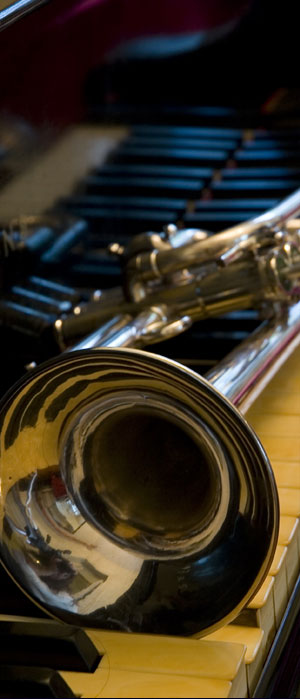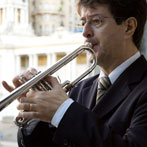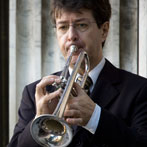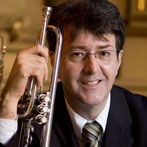
History of trumpet
The first known trumpets were made of bamboo, cane, wood, animal horns, and even seashells, as crude trumpets. The most primitive ones were used as megaphones for communication, also for magical purposes and rituals. They sang and yelled into the tubes in order to expel evil spirits. From The Bronze Age on, trumpets turned to be used mostly for martial purposes.




The earliest evidences of the existence of trumpet dates back to the year of 1500 B.C., where two trumpets were found inside egyptian pharaoh King Tutankhamun’s tomb. Such evidence had confirmed the existence of metal trumpets, as it is seen in egyptians drawings and paintings. Those two trumpets had short tubes, funnelled bells; being the longest 58cm (silver), and the shortest 49cm (bronze), partially gold-plated.
The Jews, having adopted the egyptian military trumpet, after their return from exile, may have preserved some things from their old way of blowing it, according to the traditions and playings of the Shofar (Ram’s horn). The Shofar’s most common form has a short pierced pole, forming a straight vent connecting the mouthpiece to the main cavity of the tube.
In the early ages, the trumpet had more of a sacred role. In Israel and Rome, its ‘sacred’ image turned out that only the priests were allowed to use them. The romans named The Etruscan, the best-known metalworkers at that time( 1750 B.C.), the ‘inventors’ of the trumpet.
Among these instruments, the cornu, the Litus and the Tuba*, which is the most reverenced of the Roman instruments, icon of power and the heroic achievements, left a legacy to posterity. These instruments can be seen in well-known films like Ben-hur and Spartacus, in the roman parades scenes. Within the fall of the Roman empire, the trumpet almost vanished from Europe, reborning in the Crusades period, where it was mostly used for military purposes.
During the 14th century, the short trumpet became rare, because the performers wanted to reach lower notes. As a result, instruments with longer tubes started to be produced and manufactured. We can mention the long and straight-forward instrument measuring approximately 1.50m, and the low-pitched long tube trumpet, shaped in S. For these trumpets, the terms clarion and trumpet must be applied, respectively. Both types of horns were seen in the battlefield scenario, jointly or separately.
The natural trumpet became known of circa 1590, in Germany (Nuremberg), and in England. They had crafted 5cm to 80cm round turns, reaching the bells. The tuning of the horns depend on the length of the tubes and and each horn has their own single harmonic sounds and tonalities.
The musician had to choose the right trumpet for each specific piece. If there were modulations, he needed to have other instruments in hand, with the appropriate pitch.
In 1793, Nessman, a Young blacksmith and amateur musician from Hamburg, created a chromatic trumpet with Keys (like the ones in clarinets and flutes). The famous Trumpet Concerto in E flat, of
Haydn (1796) was unquestionably destinated to a Keyed trumpet. The piece was written to Anton Weidinger, the Best trumpetist of Viena( Austria) at the time.
In 1814, Heinrich Stölzel developed the first valve for a brass instrument: the Stölzel valve. He went on to develop various other designs, some jointly with other inventor musicians, until He finally developed the three-valve model. Stölzel was a musician and composer. He played many instruments, such as the trumpet, the french horn, the violin and the harp. His repertoire consists of many symphonies, oratories, cantatas and concertos, including the Concerto for trumpet in D major (and string orchestra), recorded by famous trumpetist Maurice André.
Here are some other special types of trumpets: the Slide trumpet(1725), frequent in the Baroque Age;
the Bass trumpet(1830), used in pieces of Wagner; and the cornet (1840), a trumpet with a shorter
but wider bell, with a smoother sound, used in many pieces of great composers, mainly Tchaikovsky.
There is also the fluegel-horn (smooth tone instrument), developed around 1860, widely used in
popular music; the Piccolo trumpet ( Bb- A), developed in the 20th century (1950). Those in A, used in
Baroque music, and in Bb, used in pieces as Bolero, of Ravel, and The Rite of Spring, of Stravinsky;
the Bb trumpet with lighter metal alloy (bright tone) or heavier (dark tone), frequent in both classical and
popular music. We can still mention the trumpets: in C, mostly used in symphonic orchestra, Eb, used
in concertos in the classical period (Eb), and in Symphonic pieces, like Symphony # 9 of Beethoven
(D). Bringing to a completion, the G and F trumpets are barely used, because they can easily be
replaced by the Piccolo and Eb, respectively.
*Regardless of the term Tuba, is a trumpet with a tube that unfolds gradually into a bell.

